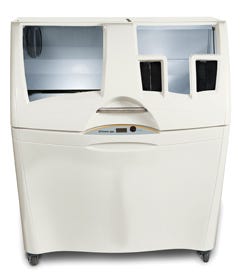In the past year, several companies have introduced new additive-manufacturing (AM) systems to the market, including Electro Optical Systems (EOS; Germany), Objet Geometries (Israel), MCOR Technologies (Ireland), MTT Technologies Group (England), and three U.S. companies—Optomec, 3D Systems, and Z Corp., according to an update from Terry Wohlers of Wohlers Associates.
October 16, 2009
In the past year, several companies have introduced new additive-manufacturing (AM) systems to the market, including Electro Optical Systems (EOS; Germany), Objet Geometries (Israel), MCOR Technologies (Ireland), MTT Technologies Group (England), and three U.S. companies—Optomec, 3D Systems, and Z Corp., according to an update from Terry Wohlers of Wohlers Associates.
On October 15, Z Corporation looked to alter the competitive landscape by announcing the world’s first automated, monochrome 3D printer, the company announced. It will be the company’s most affordable, automated 3D printer to date. Even with its time-saving automation features to simplify printing, office-safe build materials, aggressive dust-control, and zero liquid waste, the new machine creates finished parts at a fraction of the cost and effort of other systems.
|
“The ZPrinter 350 is an ideal choice for organizations seeking the most affordable way to produce single-color prototypes fast for early concept evaluation and functional testing, painted parts for a finished look, or patterns for casting applications,” says Joe Titlow, director of product management.
Z Corp. has been developing its line of 3D printers with its goal over last five years of getting easy-to-use, cost-effective printers into the hands of designers and engineers. “As a company, across our product line, when you have a 3D machine right next to you, you are only a few hours from screen to a part in hand,” says Titlow. “The extremely low cost —$2-$3 per cubic inch per part—and the fact that it is extremely fast means it can be treated like a traditional laser printer. This is where we want this tech to end up.”
The high resolution (300x450 dpi) and detail accuracy mean the ZPrinter 350 offers advanced rapid prototyping technology that converts 3D data into physical models quickly and easily. “We determined that 3D printing needs to be as close to a push-button solution as possible,” Titlow says.
The vertical build speed is 0.8 inches/hr (20 mm/hr), a speed unmatched by other RP machines, notes Titlow, in a full-size build box, 8 inches by 10 inches by 8 inches deep. “A build box of this size allows designers and engineers more flexibility in part creation,” he says. “They can do larger-sized full parts rather that partial parts that must be adhered together. It also gives people the ability to build several smaller parts at once.”
Material for Z Corp.’s RP printers is an engineering composite powder in a binder solution. “That powder, for us, is a plaster-based material,” says Titlow. “We look at the materials from a slightly different perspective. Even for people designing plastic parts, the up-front phase is primarily initial concepts, so we’re very focused on the front end where all the innovation happens. The better you are at doing the front end, the more innovative your products will be. To be able to do lots of concepts is the key, even though it might not be the exact material the product will be in, but that’s not important at the front end.”
Z Corp.’s materials can be treated in various ways so engineers can test the function of a particular design. “There are no fatigue or ductility properties to our material, but RP parts can be functionally evaluated,” Titlow explains. “A part made in an injection mold tool, at the end of the day, will be very different than most RP parts. You can’t RP a perfect surrogate. The key is testing the design until you tool up. Primarily, RP for Z Corp. is getting perfect simulation, and what you value up front is the ability to generate a part with accuracy and detail.”
The ZPrinter 350, which sells for $25,900, will fulfill the company’s mission to make RP technology more accessible and user friendly. “At this price point, it is the absolute lowest cost in the industry and the most competitive in the marketplace,” says Titlow.
The ZPrinter 350 also provides for integrated recycling of unused material.
New materials/systems
In Q4 2008, chemicals giant Huntsman Advanced Materials (Switzerland) surprised many when it announced the development of an entirely new additive-manufacturing process and machine. In early 2009, Stratasys introduced the $14,900 uPrint system based on FDM technology. ReaLizer (Germany), and Bits from Bytes (England) also introduced systems, said Wohlers in his update.
In 2001, 3D Systems was the unit sales leader, with an estimated 415 machines sold that year. Sales then declined significantly the following two years. In 2003, Stratasys took over as the company with the largest installed base and has since extended its lead, noted the Wohlers update. Through the end of 2008, Stratasys had sold 11,366 FDM systems, compared to an estimated 4274 by 3D Systems. With an installed base of 4975 systems, Z Corp. pulled ahead of 3D Systems in 2008 with the second-largest number of installations worldwide. —Clare Goldsberry
About the Author(s)
You May Also Like






